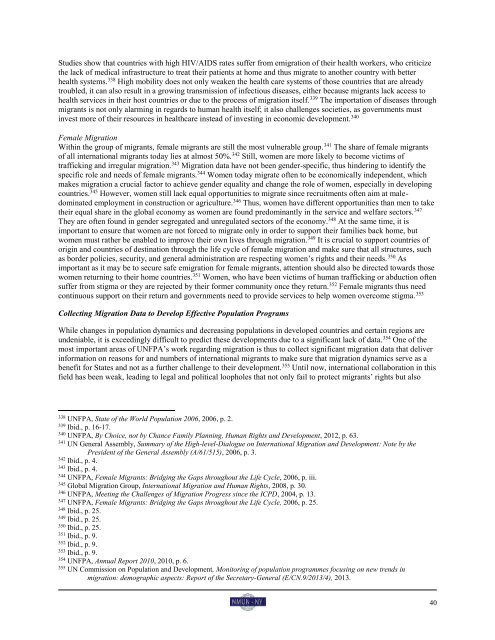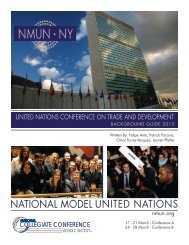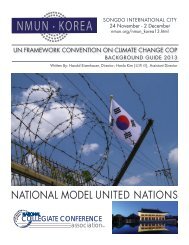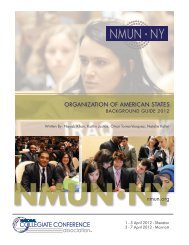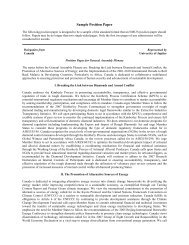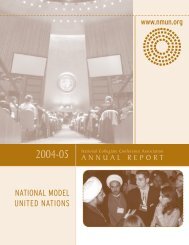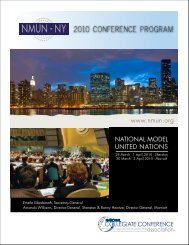UNFPA Background Guide - National Model United Nations
UNFPA Background Guide - National Model United Nations
UNFPA Background Guide - National Model United Nations
You also want an ePaper? Increase the reach of your titles
YUMPU automatically turns print PDFs into web optimized ePapers that Google loves.
Studies show that countries with high HIV/AIDS rates suffer from emigration of their health workers, who criticize<br />
the lack of medical infrastructure to treat their patients at home and thus migrate to another country with better<br />
health systems. 338 High mobility does not only weaken the health care systems of those countries that are already<br />
troubled, it can also result in a growing transmission of infectious diseases, either because migrants lack access to<br />
health services in their host countries or due to the process of migration itself. 339 The importation of diseases through<br />
migrants is not only alarming in regards to human health itself; it also challenges societies, as governments must<br />
invest more of their resources in healthcare instead of investing in economic development. 340<br />
Female Migration<br />
Within the group of migrants, female migrants are still the most vulnerable group. 341 The share of female migrants<br />
of all international migrants today lies at almost 50%. 342 Still, women are more likely to become victims of<br />
trafficking and irregular migration. 343 Migration data have not been gender-specific, thus hindering to identify the<br />
specific role and needs of female migrants. 344 Women today migrate often to be economically independent, which<br />
makes migration a crucial factor to achieve gender equality and change the role of women, especially in developing<br />
countries. 345 However, women still lack equal opportunities to migrate since recruitments often aim at maledominated<br />
employment in construction or agriculture. 346 Thus, women have different opportunities than men to take<br />
their equal share in the global economy as women are found predominantly in the service and welfare sectors. 347<br />
They are often found in gender segregated and unregulated sectors of the economy. 348 At the same time, it is<br />
important to ensure that women are not forced to migrate only in order to support their families back home, but<br />
women must rather be enabled to improve their own lives through migration. 349 It is crucial to support countries of<br />
origin and countries of destination through the life cycle of female migration and make sure that all structures, such<br />
as border policies, security, and general administration are respecting women’s rights and their needs. 350 As<br />
important as it may be to secure safe emigration for female migrants, attention should also be directed towards those<br />
women returning to their home countries. 351 Women, who have been victims of human trafficking or abduction often<br />
suffer from stigma or they are rejected by their former community once they return. 352 Female migrants thus need<br />
continuous support on their return and governments need to provide services to help women overcome stigma. 353<br />
Collecting Migration Data to Develop Effective Population Programs<br />
While changes in population dynamics and decreasing populations in developed countries and certain regions are<br />
undeniable, it is exceedingly difficult to predict these developments due to a significant lack of data. 354 One of the<br />
most important areas of <strong>UNFPA</strong>’s work regarding migration is thus to collect significant migration data that deliver<br />
information on reasons for and numbers of international migrants to make sure that migration dynamics serve as a<br />
benefit for States and not as a further challenge to their development. 355 Until now, international collaboration in this<br />
field has been weak, leading to legal and political loopholes that not only fail to protect migrants’ rights but also<br />
338<br />
<strong>UNFPA</strong>, State of the World Population 2006, 2006, p. 2.<br />
339<br />
Ibid., p. 16-17.<br />
340<br />
<strong>UNFPA</strong>, By Choice, not by Chance Family Planning, Human Rights and Development, 2012, p. 63.<br />
341<br />
UN General Assembly, Summary of the High-level-Dialogue on International Migration and Development: Note by the<br />
President of the General Assembly (A/61/515), 2006, p. 3.<br />
342<br />
Ibid., p. 4.<br />
343<br />
Ibid., p. 4.<br />
344<br />
<strong>UNFPA</strong>, Female Migrants: Bridging the Gaps throughout the Life Cycle, 2006, p. iii.<br />
345<br />
Global Migration Group, International Migration and Human Rights, 2008, p. 30.<br />
346<br />
<strong>UNFPA</strong>, Meeting the Challenges of Migration Progress since the ICPD, 2004, p. 13.<br />
347<br />
<strong>UNFPA</strong>, Female Migrants: Bridging the Gaps throughout the Life Cycle, 2006, p. 25.<br />
348<br />
Ibid., p. 25.<br />
349<br />
Ibid., p. 25.<br />
350<br />
Ibid., p. 25.<br />
351<br />
Ibid., p. 9.<br />
352<br />
Ibid., p. 9.<br />
353<br />
Ibid., p. 9.<br />
354<br />
<strong>UNFPA</strong>, Annual Report 2010, 2010, p. 6.<br />
355<br />
UN Commission on Population and Development, Monitoring of population programmes focusing on new trends in<br />
migration: demographic aspects: Report of the Secretary-General (E/CN.9/2013/4), 2013.<br />
40


